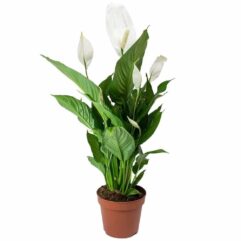Although it can be tricky to grow, a mango tree can make an interesting specimen for a large pot on a deck or patio, or for indoor use. In the right conditions, the plant forms a dense canopy of long oblong green leaves and rewards you with flowers in December through March and fruit three to five months later. Specimens planted in the garden are more likely to fruit, but even a dwarf spotted mango can produce fruit if it gets plenty of light.
-
 test productSale!
test productSale!Rs.10.00Rs.1.00 -
 Spathiphyllum or spath or peace lilies Live PlantSale!
Spathiphyllum or spath or peace lilies Live PlantSale!Rs.1,000.00Rs.850.00 -
 Thai all season grafted mango plant for pot and gardenSale!
Thai all season grafted mango plant for pot and gardenSale!Rs.2,250.00Rs.1,750.00
You can start a mango tree by planting the seed from a fruit, but if you want the tree to bear fruit, you should buy a grafted plant instead. The mango fruit you buy in the store is likely from a hybrid, so a plant grown from its seed won’t grow and is likely to be sterile or unable to bear fruit. There are many dwarf varieties of mango available that will produce a plant of manageable size rather than the landscape versions that can often reach 60 to 100 feet.
Be forewarned, though, that it’s difficult to keep an indoor mango plant alive for more than a few years, and it may never mature enough to bear fruit. Mango trees in the outdoor garden or potted on a deck or patio usually fare somewhat better.
- Choosing a Right Variety
A dwarf mango tree grows up to 2-4 meters, 6.5 to 13 feet tall and can be tried in containers. There’re some specific dwarf varieties of the mango tree that you can grow in a container; Irwin and Nam Doc Mai are best. Some other varieties you may try are King Thai, Carrie, Cogshall, Glenn, Neelam, Amrapali, and Palmer. - The Best Time for Planting
The best time for planting a mango tree is in spring. However, in their native habitat like India, mangoes are planted before the beginning of the rainy season at July, August or after the rainy season. Plant it in a planter according to the current size of the rootball of the plant and update the planter as the plant gets bigger in a year or two or whenever it’s required. You’ll need a large pot to accommodate a mango tree. - Soil and Position
It needs light, well-drained soil that is very rich in organic matter. The pH level around 5.5 to 7.5 slightly acidic to neutral. Instead of using regular soil from the garden, use a high-quality potting mix. Also, at the time of planting, add 1/3 part compost or aged manure in the mix.
Mango tree needs a lot of sun and heat to thrive. Almost 8-10 hours of exposure to the full intense sun is required for optimum growth and productivity of the plant. Place the mango tree in a container in the South or West facing position of your garden.
- Watering
Mango trees grown on the ground don’t require much watering, but container grown plants are different. You’ll need to water your mango plant regularly in its first two to three years. Once the tree is established and mature enough to bear fruits, start to water moderately during the pre-flowering period. Keep doing this until 40 to 50 percent of the tree is full of flowers and then water regularly from flowering stage to fruit formation, until a few weeks or a month left before harvesting the mangoes. During this time, start to water moderately again. - Fertilizer
Feed it with the balanced fertilizer when actively growing. At the beginning of blooming season decrease the amount of nitrogen and feed your mango tree with high in potassium and phosphorus fertilizer. - Pinching and Pruning
Continuous pinching encourages bushier growth. The mango tree doesn’t require a lot of pruning. However, it’s necessary to remove dead, diseased and entangled branches that are causing the lack of air circulation and penetration of sunlight to control its shape and health. - Harvesting a Mango Tree
After flowering, mango fruits start to ripe within the next 3 to 4 month, all depends on the climate, and the variety you’re growing. In hot and humid climates, fruits ripen fast. Pluck fruits when their scent become sweet and tempting. You can harvest unripe fruits too, these are used in making sherbet, pickles, chutneys, and curries.
-
 test productSale!
test productSale!Rs.10.00Rs.1.00 -
 Spathiphyllum or spath or peace lilies Live PlantSale!
Spathiphyllum or spath or peace lilies Live PlantSale!Rs.1,000.00Rs.850.00 -
 Thai all season grafted mango plant for pot and gardenSale!
Thai all season grafted mango plant for pot and gardenSale!Rs.2,250.00Rs.1,750.00
Even dwarf mango trees will grow quite tall, so you will need to consider that when choosing a location for it. Dwarf mangos are most often grown in large pots, either indoors or on a deck or patio, in a container with good drainage filled with loose, rich, well-draining potting soil. Don’t expect your mango tree to blossom until it is four years old or more. The second year, you can let it set fruit, but be sure to stake the plant so it will have enough support as the fruit develops.
Source:
https://balconygardenweb.com/how-to-grow-mango-tree-in-pot/
Song: Ikson – Lights (Vlog No Copyright Music)
Music promoted by Vlog No Copyright Music.
Video Link: https://youtu.be/bqk80OOCxOQ
